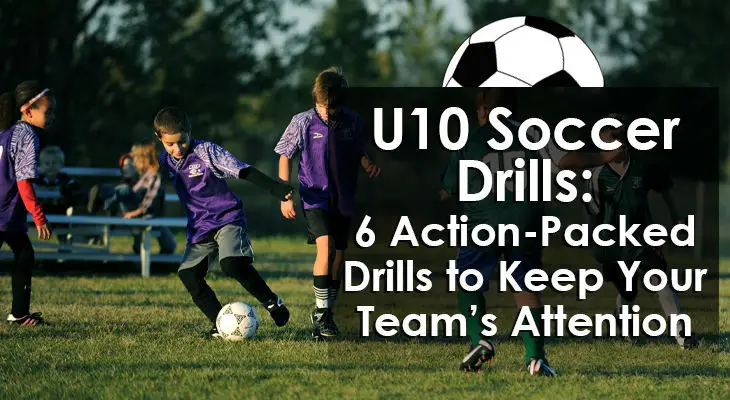U10 Soccer Drills: 6 Terrific Drills for 10-Year-Olds
Coaching the 10-and-under age group isn't always easy...
If you're not using U10 soccer drills that keep them focused and engaged, you'll find players around this age can become distracted very easily.
Which isn't a good thing for your training sessions (or the players around them).
To help you keep them focused, here are 6x U10 soccer drills I recommend using.
The drills are competitive, high intensity, and will improve the skills of your players.
Enjoy!
6x U10 Soccer Drills
1. 2v1 Dribbling End Zones
How the Drill Works:
Two attackers play against one defender to end zones. A point is scored if the attackers dribble into the end zone, or if the defender wins the ball and dribbles out-of-bounds under control. No points are awarded if the ball is kicked out-of-bounds.
Purpose:
Develop players’ abilities to take advantage of 2v1 situations. Players improve their 1v1 moves, decision-making and passing skills.
Setup:
- Set up two field 20x25-yard fields. Mark out a five-yard end zone on one end line of each field. See diagram for clarification.
- Place one cone on each end of the two fields for players to form lines on. See diagram.
- Assign two defenders for each field with matching jerseys. One defender starts inside each field with the other defender resting just outside the field.
- Two attackers start on each field. One attacker starts inside the field while the other attacker starts on the end line opposite of the end zone.
- The remaining players form even lines, with soccer balls behind each extra cone on each side of the fields.
- Play four-minute games before resting and rotating defenders. Play for at least 20 minutes.
Instructions:
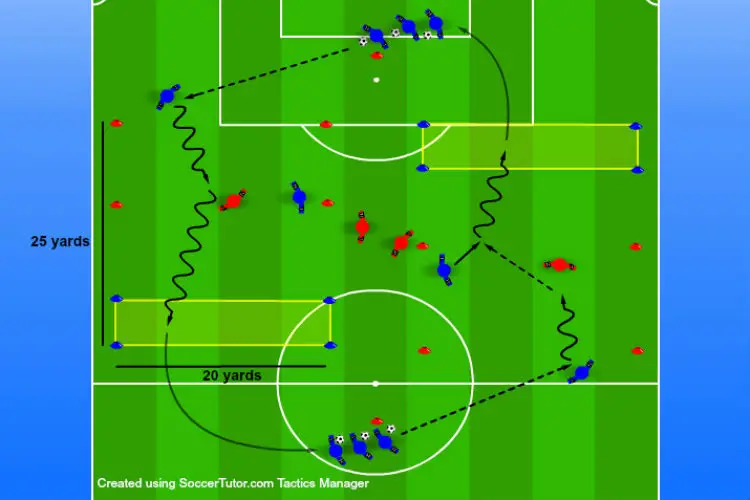
- The first player in each line, passes their ball to the attacker on the end line of each field.
- The attacker receives the pass and then dribbles into the field.
- The attacker plays 2v1 against the defender and attempts to score by dribbling into the end zone.
- If the defender wins the ball, they score by dribbling out-of-bounds for a point.
- The repetition is over when any player scores, or the ball goes out-of-bounds for any reason.
- Defenders rotate after each repetition with the other defender on their field.
- The attacker that scores or is closest to the end zone when the repetition is over, takes the ball to the back of the attacking line behind the end zone. The passer becomes the new attacker on the end line and the attacker from the last repetition starts inside the field.
- The next repetition begins as soon as the new defender is set.
- Play for four-minutes before assigning new defenders. Play for at least 20 minutes.
Variations:
Competition – Have the players keep track of their points! Player with the most points at the end of each four-minute round is the winner!
3v1 – If the attackers are struggling to consistently beat the defender, add another attacker to play 3v1.
Width – Decrease the width to make it more difficult on the attackers. Go to 12-15 yards wide.
Coaching Points:
- Teach the attackers to commit the defender before passing the ball to their teammate. If the defender cuts off the pass, the attacker will need use a change of speed, or direction move to get past the defender.
- Encourage the attackers to provide good passing angles for each other.
- Challenge the defenders to win the ball and transition out-of-bounds for a point!
2. 2v2+2 Crossing & Finishing
How the Drill Works:
Two teams of two players with the help of two neutral players compete to score the most goals in the round. One neutral player on each sideline is free to move up and down the line while passing and crossing to the team in possession.
Purpose:
Competitive 2v2 game inside a small playing area that develops crossing, finishing, defending and movement skills. Players are constantly getting repetitions while shooting and defending.
Setup:
- Set up a 30x35 yard field. The field should be wider than it is long to focus on the use of the wide players and crosses.
- Place one full-size goal on each end line.
- Position one goalkeeper in each goal. If there are extra goalkeepers rotate them in after every round.
- Divide the players into teams of two and assign each team a different colored jersey. If there are more than five teams, create two fields to give the players more repetitions.
- Have two teams start in the center of the field. Assign each team to defend a different goal.
- Have one other team be the starting neutral players. Position one neutral player on each sideline. Tell the neutral players they are free to move up and down the sideline as well as 3-4 yards outside the line.
- Divide all the soccer balls between the goals.
- One goalkeeper starts with a ball.
- Each team should complete at least four, three-minute games. Add more time or games as needed. Make coaching points between rounds.
Instructions:
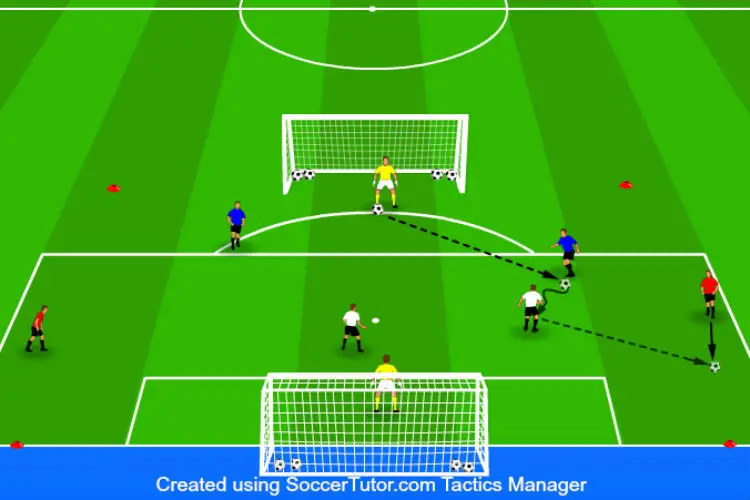
- On the coach’s signal, the goalkeeper passes the ball to their teammates and the players compete 2v2 plus the two wide neutral players.
- Players are free to score through the run of play or off a cross from the neutral players.
- Neutral players move along the sidelines and pass, or cross, the ball to the team that passed them the ball. Neutral players can dribble along the sideline to deliver a cross if needed.
- Neutral players can not be defended.
- Goalkeepers can pass to the neutral players directly and be a part of their team’s possession.
- When a goal is scored, the goalkeeper from the scoring team starts a new ball from their goal. Make it, take it rules.
- If the ball goes out-of-bounds, the team that did not touch the ball last starts with a new ball from their goalkeeper.
- The team with the most goals scored at the end of the round wins.
- Teams rotate after each round. The neutral players come onto the field while one team becomes the neutral players.
- Each team should complete at least four, three-minute games. Add more time and games as needed.
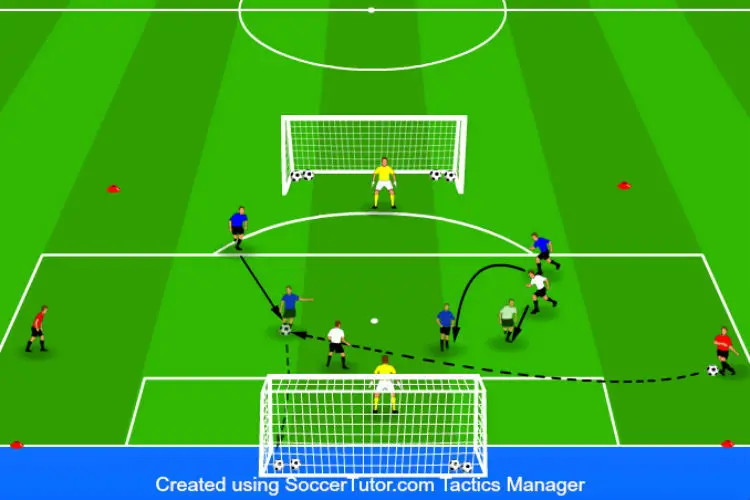
Variations:
Crossing – Teams can only score off crosses, or passes from neutral players.
Touch limit – Give the field players, or neutral players a touch limit to increase the tempo of the game and make the players think faster. Give the players three, two, or one touch depending on level. Field players and neutral players can be given different touch restrictions depending on the focus.
King of the hill – The winning team after each round stays on the field while the team that lost becomes the neutral players.
Point system – Award one point for a goal off a shot from one of the field players. Two points for a goal off a cross using the feet. Three points for a goal off a cross using the head.
Numbers – Make it 3v3, 4v4, etc. Increase the size of the field as more players are added.
Coaching Points:
- Teach the players to constantly move on both the offensive and defensive side of the ball! This game is demanding and requires much movement from the players.
- Educate the players to keep their head and eyes moving to read the game. Seeing the field and where players are will allow players to make better decisions and give themselves a better chance of scoring.
- Remind the players to be decisive with their movements and passes. Players should make quick, quality decisions.
- Teach the players to attack the crosses, both defensively and offensively, and try to be the first one to the ball.
- Challenge the players to be explosive and creative on the ball when dribbling. Players should take the opportunity to shoot as soon as there is space!
- Motivate the goalkeepers to communicate with their team and to be quick between the posts!
3. 4v4+4 Wide Players
How the Drill Works:
Two teams of four players plus goalkeepers compete against each other on full-size goals. Teams must complete one pass to one of the four wide neutral players before scoring on goal.
Purpose:
Develop the entire player through a game-like activity. Players work on their ability to play wide and score goals from wide passes or crosses.
Setup:
- Set up one, 30x45-yard field.
- One full-size goal should be placed on each end line.
- Divide the players into three teams of four field players and one goalkeeper. If there are only two goalkeepers available, position them in goal without assigning them to a team.
- Two teams start on the field while the third team spreads out evenly along the two sidelines to start as the neutral wide players. Teams will rotate after each round.
- All of the soccer balls should be placed in the full-size goals.
- Play four-minute games. Teams should play each other at least twice.
Instructions:
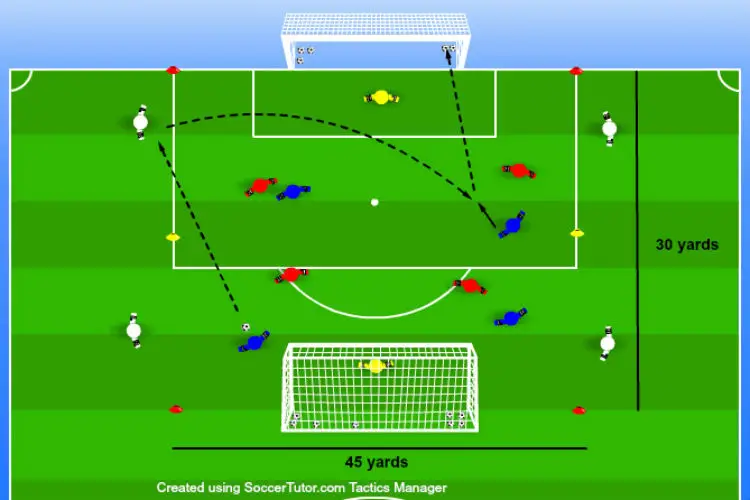
- Two teams compete against each other and attempt to score goals in their opponent’s goal.
- Teams must connect at least one pass to a wide neutral player before attempting to score on goal.
- If the ball goes out-of-bounds for any reason, a new ball is started with the goalkeeper of the team that did not last touch the ball.
- Players can not steal the ball or defend the neutral players.
- If a team scores a goal, a new ball is started with that team’s goalkeeper. Make it, take it.
- Neutral players are free to move along the sidelines.
- The team with the most goals at the end of the four-minute game wins the round.
- Between rounds, reset the soccer balls and rotate teams.
- Teams should play each other at least twice. Team with the best record at the end wins the activity.
Variations:
Touch-limit – Give players three, two or one-touch to increase the difficulty.
Neutral touch-limit – Give the neutral players a touch limit.
Score from a cross – Players must score from a neutral player cross. Passes can be on the ground or in the air.
Scoring points – Three points for a header out-of-the-air. Two points for a one-time finish. One point for a two-touch finish.
Coaching Points:
- Teach the players to play wide. The outside is where the space and open players are.
- Remind the wide neutral players to pick their head up and deliver a good cross to players running into the box.
- Encourage the players on the field to make hard runs into the box to get on the end of the crosses.
- Let the wide neutral players know that they do NOT need to cross the ball every time they get. Wide neutral players can help keep possession and set other players up without always crossing the ball.
- Challenge the players to score often and work on both sides of the ball!
4. 5v5 Wall Pass Scoring
How the Drill Works:
Two teams of three compete to connect passes to their teammates on opposite end lines. Teams look to keep possession using their teammates inside and outside of the field.
Purpose:
Develop directional possession skills. Players improve their decision-making and passing as they move the ball forwards and backwards.
Setup:
- Set up at 25x25 yard field.
- Divide the players into two teams of five. Teams can be larger than five, but then adjust the field to fit the number of players.
- Two players from each team start on opposite sidelines as the wall players. The remaining players start inside the field. See diagram for more information.
- One team starts with the ball.
- Gather the extra soccer balls near the coach.
- Play four, four-minute rounds. Rotate wall players and make coaching points after each round. Add more time and rounds as needed.
Instructions:
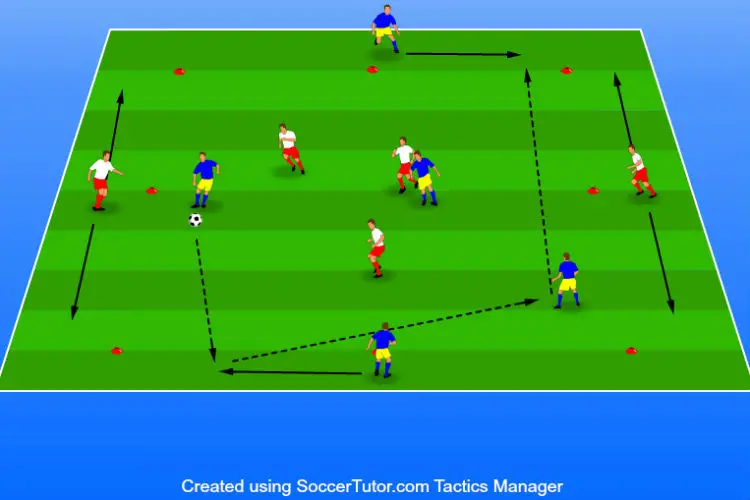
- Teams play possession attempting to connect passes to their wall players.
- Teams must maintain possession of the ball and connect a pass to each of their wall players for a point. If teams lose possession after connecting one pass, they must restart when the retain possession.
- Wall players are free to move along their entire sideline.
- Wall players can not defend but can be defended.
- Teams are free to use the same wall player as many times in a row but are not awarded a point until they alternate wall players in the same possession.
- The players inside the field stay inside the field for the duration of the round.
- If the ball goes out-of-bounds the team that did not last touch it, starts a new ball.
- Play four, four-minute rounds. Add more rounds and time as needed. Rotate wall players and make coaching points between rounds.
Variations:
Touch limit – Give players three, two, or a one-touch restriction.
Number of players – Add more players to the game as needed. Adjust the field size accordingly.
Neutral players – Add one or two neutral players if teams are struggling to possess.
Coaching Points:
- Teach the players to constantly move and provide good angles of support.
- Stress the importance of having an idea before you receive the ball to increase the speed of play.
- Remind the players to play away from pressure!
- Encourage the players to communicate and help each other with decision-making.
- Challenge the teams to win the ball back as quickly as they can after they lose it.
5. Tic-Tac-Toe Sprints
How the Drill Works:
Players sprint back and forth between a tic-tac-toe setup trying to place their team’s jersey color in a winning formation. Two teams compete at each setup and take turns running out to the box to move their team’s jersey markers until one team gets three in a row.
Purpose:
Fun activity for players to compete against each other while also building fitness through repeated sprints. Players increase their max speed and quickness.
Setup:
- Divide the players into teams of three to four players. If possible, use an even number of teams so that no team must sit out.
- Depending on the number of teams create a tic-tac-toe box for every two teams. Use cones or agility hoops to create the game.
- Set up a cone gate 15-25 yards away from each tic-tac-toe box. This will be the gate players must start at before sprinting to and from the box.
- Assign two teams to each cone gate and have each team form a line behind each cone on the gate.
- Give three colored jerseys or cones to the first three players in each team line. The two teams competing against each other must have different colored markers.
- Players keep their markers in their hands and will place them inside the box when it is their turn.
Instructions:
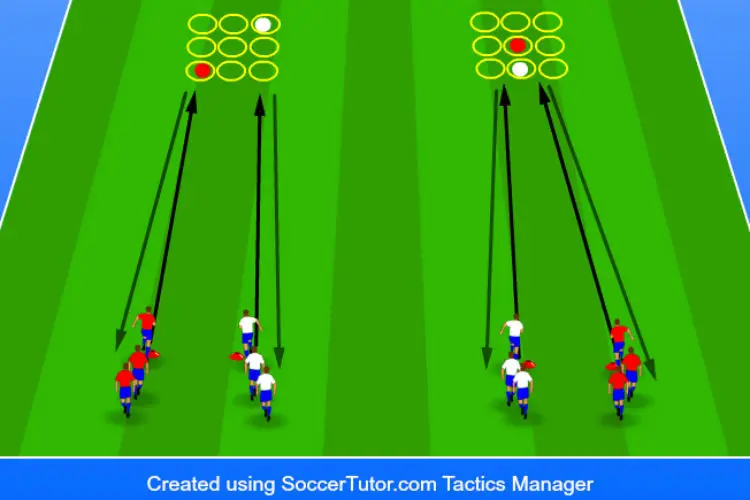
- On the coach’s signal, the first player in each team line sprints to the tic-tac-toe box, places their jersey down inside one of the nine small squares and then immediately sprints back to the starting line to tag their partner’s hand.
- Has soon as the next player’s hand is tagged, they are free to sprint to the tic-tac-toe box, place the second jersey down and then sprint back to tag their next teammate’s hand.
- The third teammate sprints to the box to repeat the process and lay down the third jersey.
- If the third jersey wins the round with a three in a row then the round is over and players rest and reset for the next round.
- If the third jersey for either team does not win the round, then the third player who just laid the last jersey, sprints back and tags the next player’s hand. The next player will either be the 4th player on the team, or the 1st player, depending on team sizes.
- As soon as the next player’s hand is tagged, they sprint out to the box and move one of their team colored jerseys to try and get three in a row. The process of moving team markers continues until one team gets three in a row and wins the round.
- After a team wins, give the players a little bit of rest, reset the activity before repeating again.
- Play for as many rounds as needed. Switch opponents if teams want!
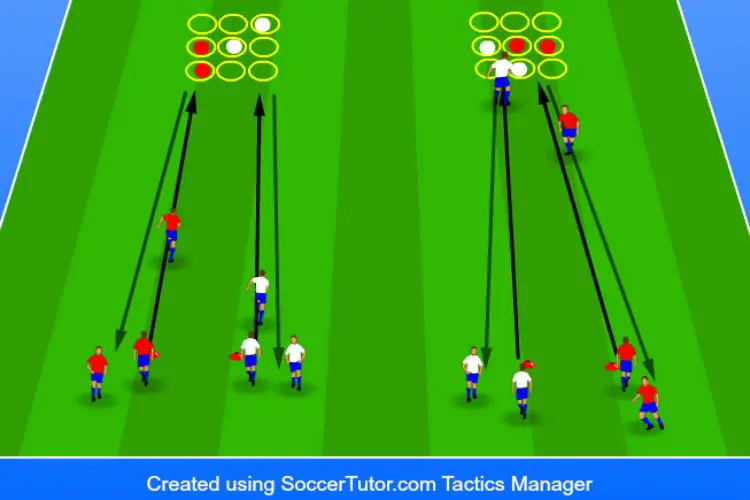
Variations:
Run with the ball – Incorporate a soccer ball into the activity. Have players dribble a soccer ball to and from the box before giving it to their next teammate to repeat the process.
Add obstacles – Add sticks, cones, or ladders that players must run around, or through, as they sprint towards the box. This will make the activity more difficult and can work on players’ agility at the same time.
Coaching Points:
- Challenge the players to sprint as fast as they can to and from the tic tac toe box.
- Remind players to choose wisely when laying their team jersey down.
- Encourage the teams to work together and motivate each other.
6. Two Goal Two Touch
How the Drill Works:
With two goals positioned 25 yards away from each other, players form one line to the side of each goal. The players pass, diagonally across to a player who has checked towards the ball. The player receiving the ball turns and shoots within two touches before the player who passed the ball checks towards the other line to start their turn.
Purpose:
Develops the ability to turn and shoot using two touches. Players get a lot of quick repetitions on goal to develop their first touch and finishing skills.
Setup:
- Two full-sized goals are needed for this activity. The two goals should be placed 25-30 yards away from each other. Adjust the distance between the two goals to best fit the needs of the players.
- Position one goalkeeper in each goal. If there are extra goalkeepers, have them rotate in every six repetitions.
- Have the players form a line to the side of each goal. The lines should be diagonal from each other.
- Divide the soccer balls evenly among the two lines.
- The first player in one of the lines starts with a ball at their feet. The first player in the other line starts 20 yards in front of their line. See diagram for more information.
- Complete two, six-minute rounds. Rest to reset the soccer balls as needed. Switch sides at half so players receive using both feet.
Instructions:
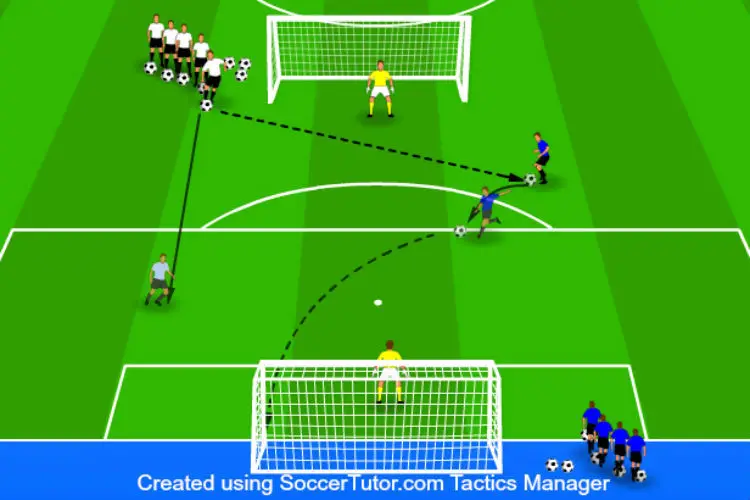
- The first player in line with a ball at their feet completes a pass to the player from the opposite line that is diagonally 10-12 yards away from the passer. The passer then runs 18-20 yards away from their starting line.
- The receiving player takes a first-touch that positions them to score on the goal furthest away from them.
- After taking their first touch, the player then attempts to score on the goal they are now facing.
- The initial passer is now in position to receive a pass from the opposite line to repeat the process.
- Shooters retrieve their ball if they missed the goal before returning to the back of their original line. Goalkeepers retrieve balls in the goal.
- Passers should start their run away from their line as soon as they complete the pass to the opposite player. The activity should move quickly allowing for continuous, alternating repetitions.
- Continue the process for the remainder of the round. Retrieve any lost soccer balls and rest between rounds. Have the lines switch to the other side of goal after the first round to work on both shooting angles.
- Complete at least two, six-minute rounds.
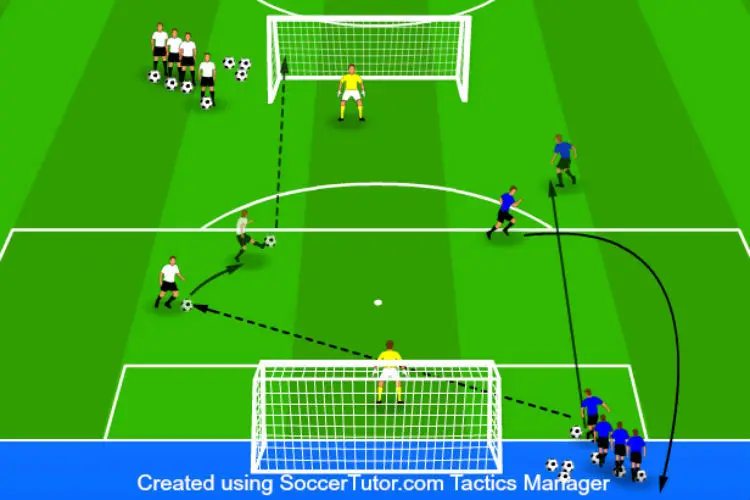
Variations:
Distance – Adjust the distance between the two goals to fit the needs of the players.
More touches – Give the players more touches if they are struggling to get quality shots off within two touches.
Pass difficulty – Have the players chip, or loft balls into the shooters to give them more of a challenge on their first touch.
Coaching Points:
- Educate the players on the importance of their first touch. Their first touch needs to be out from under their feet for them to run onto and strike. The touch should also position the shooter’s body towards the goal since the player is receiving a pass side-on.
- Challenge the players to make the finishing as game-like as possible. Players should turn and get their shot off quickly to build good habits.
- Teach the players to lock their ankle and strike through the ball smoothly as they shoot. Players are also free to use the insides of their feet to curl the ball around the goalkeeper. Players should lock their ankle regardless of the technique they are using.
- Encourage the players to be consistent and score as often as possible.
- Motivate the goalkeepers to block each shot and to get back to their feet quickly. This is a great activity for goalkeepers to get a lot of repetitions!
Further Reading: 123 Soccer Drills for All Ages and Skill Levels (With Images)

